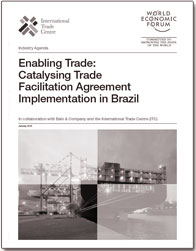World Economic Forum

Countries worldwide are implementing measures to facilitate trade, but it will take years for them to benefit from their investments. This report showcases Brazil’s approach to trade facilitation as illustrated by its Single Window project, and highlights other best practices that countries can pursue to successfully implement trade reforms.
Download the full report
Countries are implementing trade facilitation measures, but are far from achieving competitiveness
On average, the Trade Facilitation Agreement (TFA) forged at the World Trade Organization meeting in Bali, Indonesia, in 2013, has been implemented at a combined 39% rate among developing and least-developed countries, with wide variation. The focus has been on measures related to the release and clearance of goods, and to reducing the formalities in movement of goods. The TFA is effective in addressing some major supply chain barriers, but does not use all the available levers for countries to reach full trading potential. The TFA also does not cover some measures recommended in the World Economic Forum’s 2013 report, Enabling Trade: Valuing Growth Opportunities—issues related to telecommunications and transport infrastructure, for instance, and business environment. As a result, TFA implementation, while necessary, in many instances could be insufficient to make certain product segments competitive. The countries that will be the most effective will be those that view trade barriers across the end-to-end value chain in their most important industry, and then tackle those barriers to make the industry competitive. Improving that particular industry sets the stage for improvements in others.
Single Window implementation is a priority for countries
A Single Window is an electronic process in which trade and transport companies can provide standardized information and documents to fulfill import, export and transit-related regulatory requirements. Without such an option, companies must separately submit information and documentation to various agencies. The world has 73 Single Windows, but only about 18 countries have systems that connect all relevant government agencies and create a single entry point of information. Among implemented or ongoing projects worldwide, best practices can be found in Singapore, South Korea, Greece, Ecuador and Costa Rica. Each country illustrates a different, yet successful, approach, such as partnerships with the private sector. Enabling Trade: Catalysing Trade Facilitation Agreement Implementation in Brazil thoroughly examines Brazil’s exhaustive efforts to establish a Single Window—which serve as a model for implementation.
Brazil’s Single Window implementation illustrates important procedures
Border administration procedures have a major impact on trade in Brazil. In a study of private sector views, published by Brazil’s National Confederation of Industry (or CNI) in 2014, companies raised such issues as too many documents, a lack of communication among agencies, a slow and unpredictable analysis process, and sluggish inspection procedures. To solve many of these problems, Brazil launched its Portal Único or Single Window project in 2014. The goal is to make Brazil’s trade more competitive by increasing the transparency in procedures for all stakeholders and cutting export and import times. Currently, the average time for exports is 13 days and for imports is 17 days. Improved procedures could result in potential cost savings of $1.5 billion annually and could add $24 billion to Brazil’s gross domestic product or GDP, according to recent studies by Fundacao Getulio Vargas (or FGV), a Brazilian think-tank.
The Portal Único programme demonstrates good practices, including:
- Brazil has established Portal Único as a state—not a government—project supported by a presidential decree
- The private sector has been involved since the project’s start, mapping current business processes, identifying current bottlenecks and discussing solutions
- Brazil set up a managing committee to oversee the project and coordinate the other agencies in the implementation process
Portal Único will address several border administration issues raised by the private sector. For example, it will directly reduce documentation formalities and automate processes. Moreover, the Single Window will indirectly create appropriate tools to support other projects, such as the authorized economic operators programme.
Solutions and approaches may vary according to country characteristics, but some common factors contribute to successful implementation
- Governments need to prepare an overall structure that encompasses project enforcement, private sector involvement and proper governance. Next, they need to diagnose the main issues that will define the scope and phases of the project and how it connects to other current schemes. Such a diagnostic also is important to mobilize stakeholders and plan efforts. Finally, governments need to execute the plan with the appropriate support and partnership.
- Project enforcement: For a long-term, multistakeholder project in the public sector to succeed, the first step is to gather political support at the presidential level and make the project a priority for the country.
- Private sector involvement: Involving the private sector at the start in the details of project development is important to shape the solution for end-users and enhance the impact.
- Coordinating body: A coordinating body is essential to ensure effective implementation of a multistakeholder project like a Single Window. A supervisory body can align different priorities and approaches, arbitrate when necessary and speed up decisions.
- Diagnostic: Key performance indicators (KPIs) and a methodology to verify them must be established. Next, it is necessary to identify and map critical issues that affect the KPIs.
- Scope and phases: The stages of the processes must be clarified for all stakeholders, even if some institutions are not involved in some stages.
- Integration: It will be productive to have a broader, integrated trade plan that includes other programmes besides the Single Window, and describes how the programmes will help the country to meet its KPIs.
- Solution development: The technical solution for a Single Window may not be straightforward. It is beneficial to involve an experienced partner.
-
The recommendations in the Enabling Trade: Valuing Growth Opportunities report are important to remember: trade will improve only when countries reach a “tipping point” at which it becomes profitable for companies to increase trade, and to create that tipping point requires focusing on more than one element of the value chain.